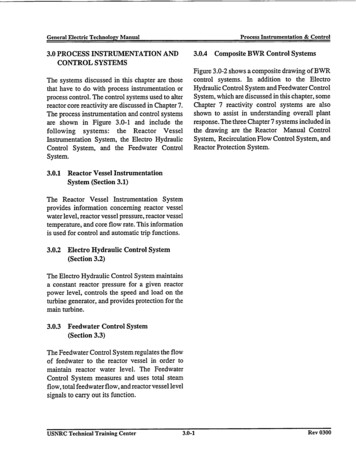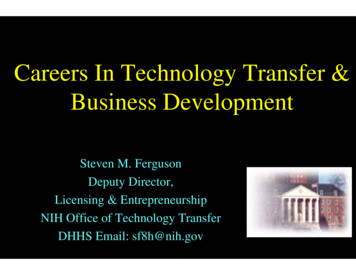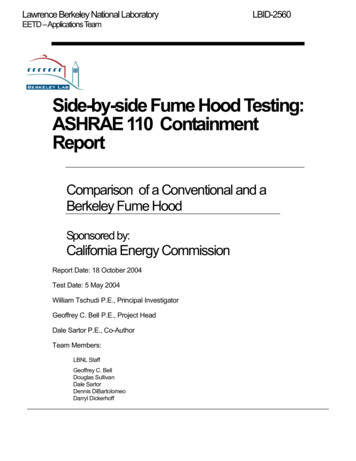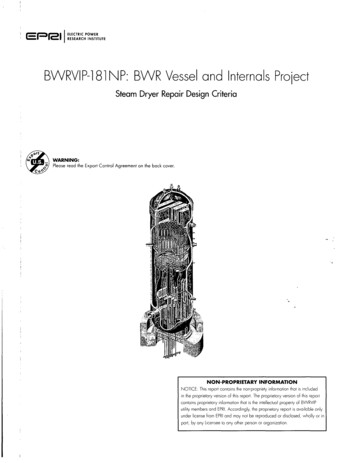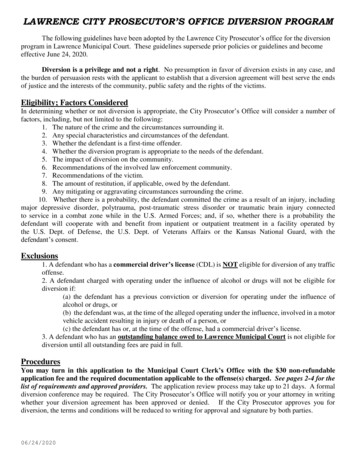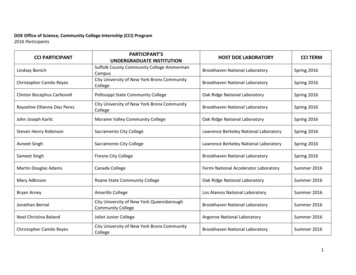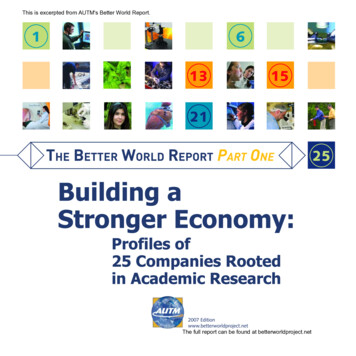
Transcription
This is excerpted from AUTM's Better World Report.16131521THE BETTER WORLD REPORT PART ONEThe full report can be found at betterworldproject.net25
This is excerpted from AUTM's Better World Report.THE BETTER WORLD REPORT PART ONEThe full report can be found at betterworldproject.net
This is excerpted from AUTM's Better World Report.Photo courtesy of Symyx Technologies, Inc.Chapter 2Berkeley Laband SymyxTechnologies:A WinningCombinationSymyx scientist using Symyx Software and Toolsfor a research collaboration program.With its unique approach to materials identification andanalysis, Symyx Technologies is helpingpowerhouse companies worldwide blaze new trailsin the realm of research and development.The full report can be found at betterworldproject.netTHE BETTER WORLD REPORT PART ONE23
This is excerpted from AUTM's Better World Report.2TTake one brilliant idea, a supportive national laboratory and a savvy technologytransfer office, and occasionally the combination will hit the jackpot. It’s all quiteLawrence BerkeleyNationalLaboratoryfitting given that the essence of this story is a technology based on the concept ofcombinations. The key elements, when brought together, resulted in the companySymyx Technologies, Inc., which today generates over 100 million in sales annually.Symyx was sparked by the innovative research of renowned scientist Peter G.Schultz, Ph.D., who began his career studying DNA, catalytic antibodies and otherSymyxTechnologiesbiological molecules. Professor Schultz was intrigued by the concept that manipulatingantibodies in different combinations yielded an exponentially higher number ofbiological products, thereby opening the door to broader testing for immune-relateddrugs. As a chemistry professor and principal investigator at the Lawrence BerkeleyNational Laboratory in Berkeley, Calif., back in the 1990s, he applied the sameapproach to the growing field of materials sciences.While conventional materials development involved creating new materials one ata time, and then painstakingly testing each one for desired qualities, analyzingcombinations of materials promised to revolutionize the process. Professor Schultz andhis colleagues at Berkeley Lab invented and reduced to practice a highly efficient andautomated process, called high throughput, for simultaneously analyzing 10,000different materials, or “combinatorial libraries.” Using the techniques of miniaturizingand simultaneous parallel processing, they designed a technology that allowed themto identify new materials with specific and desirable physical and chemical properties.These lead compounds were then analyzed and characterized to determinetheir structure.The scientists achieved their goal of applying the concept of high throughputresearch to combinatorial chemistry, and applied it to the discovery of new materials –from magnets and super conductors, to catalysts and polymers. When they publishedthis milestone in 1995, it warranted the cover story of the journal Science. That verysame year Symyx was founded.“It was a very broad concept with high risk that needed to be developed andcommercialized within an entrepreneurial venture,” says Symyx President and CEOIsy Goldwasser. “That’s why Symyx was quickly founded to advance this technology.”The full report can be found at betterworldproject.net24THE BETTER WORLD REPORT PART ONE
This is excerpted from AUTM's Better World Report.New Strategies for Successful Technology Transfer2The partnership between Symyx and the Berkeley Lab Technology TransferDepartment was somewhat unusual, but proved to be beneficial to both parties.According to Viviana Wolinsky, licensing manager at the Berkeley Lab, the Symyx-BiotechnologyBerkeley license transaction is believed to be the first of its kind whereby a nationallab accepted partial payment in the form of equity. This arrangement allowed thestartup company, based on the core intellectual property created at the Berkeley Lab,to devote more of its initial capital to developing the promising technology.“As a Department of Energy lab, we’re always keen to make appropriate choiceswith licensing,” says Wolinksy. “We realized that Symyx had a great plan from thestart — it made the right choices and has really gone far beyond initial plans.”The original funding for the work was an 80,000 grant to Professor Schultz for hisresearch from Berkeley Lab’s Laboratory Directed Research and Development (LDRD)Program. The LDRD program is a source of discretionary funding that awards grantsthrough a scientific and management peer review process for early-stage projects thatare directed to the advanced study of hypotheses, concepts, or innovative approachesto scientific problems.By 1998, Symyx had raised 38.7 million from a variety of private and venture sources, including Alejandro Zaffaroni, Bayer INNOVATION, Chemical andMaterials Enterprise Associates, Institutional Venture Partners (which is nowVersant Ventures) and Venrock Associates. The company, headquartered inSanta Clara, Calif., went public in 1999 and is listed on NASDAQ.Today Symyx is an impressive example of a federally funded technology thatresulted in a vibrant and profitable startup, creating hundreds of high-valuejobs. Symyx has more than 375 employees, the majority of whom are highlevel scientists and technical staff.Chemist using Symyx Software to design and executeexperiments. Photo courtesy of Symyx Technologies, Inc.“We’re proud of this job creation, as well as other direct and indirect effects oneconomic development,” says Wolinsky. “Symyx has become a research powerhousefor other businesses both nationally and abroad.”Symyx’s performance continues to shine. Last year the company reached over 108million in revenue. Goldwasser says that as the first company worldwide to offer thistechnology, it has built a leadership role and therefore gains the most business andThe full report can be found at betterworldproject.netTHE BETTER WORLD REPORT PART ONE25
This is excerpted from AUTM's Better World Report.the most investments. Currently its equity is worth approximately 750 million, a2value that has benefited both the Berkeley Lab and other Symyx shareholders.Impacting the Big IndustriesLawrence BerkeleyNationalLaboratoryThe list of materials and technologies that have emerged from the company’sfounding technology continues to grow, as does the list of pharmaceutical, chemical,energy and electronics companies that have benefited from Symyx Tools, Softwareand research services. Two of the company’s more prestigious clients are ExxonMobiland Dow Chemical, and each has made a long-term commitment to change itsSymyxTechnologiesorganization to conduct research and development the way Symyx does,according to Goldwasser.“Industry-leading companies like these don’t usually seek help from outsiders, so it’sbeen a big shift for them,” he says. “This exemplifies how Symyx has changed anindustry that is normally very resistant to change.”The materials that have been developed in the years since Symyx introduced itsbroad methodology include new polymers, chemical catalysts and specialty formulations. With over 320 issued patents, Symyx has the largest portfolio of any companydevoted to high throughput materials discovery.“Most technologies out of universities and national labs are very early stage technologies that need further nurturing and are not ready to jump out of the lab and intothe marketplace,” says Wolinksy. “But Symyx was able to take a very early stagetechnology, and a great concept, and exploit it to its fullest so that it’s now providinghuge value across an entire panoply of industrial sectors. It’s very rewarding to see alicensee that has devoted its resources and creative energies so well.”Goldwasser, who began his involvement with Symyx as a summer student withSchultz, is perhaps most proud of the way in which Symyx is changing the field ofmaterials sciences.“We have been very profitable and very fast growing for a small company,”he says. “What’s most impressive for everyone is that we have really achieved whatwe initially defined as our overall vision — to change the way that research anddevelopment is conducted, by making it faster, better and more efficient.”— By Nicole ResnickThe full report can be found at betterworldproject.net26THE BETTER WORLD REPORT PART ONE
This is excerpted from AUTM's Better World Report.Chapter 10Aeroseal equipment being prepared to inject sealant into anexhaust duct system on the UC-Davis campus in February 2006.Photo courtesy of Carrier AerosealAeroseal, now a division of Carrier Corp.,CarrierAeroseal:SealingHeating andAirConditioningLeaks from theInside Outrevolutionized the process of searching for,and sealing, hidden leaks in heating and air ducts.The full report can be found at betterworldproject.netTHE BETTER WORLD REPORT PART ONE63
This is excerpted from AUTM's Better World Report.10MMove over duct tape, a new competitor on the market is getting the job donefaster and with more energy savings.Lawrence BerkeleyNationalLaboratoryLong thought to be the right solution for stopping leaks around hot or cold airducts, fabric-backed duct tape fails to seal leaks in ducts and pipes, according toLawrence Berkeley National Laboratory in Berkeley, Calif.Instead, Aeroseal duct-sealing technology, invented and developed by the EnergyPerformance of Buildings Group at Lawrence Berkeley National Laboratory, is makingCarrier Corp.waves for its ability to seal more leakage because of its unconventional method ofgetting at inaccessible leaks.Each year about 5 billion of energy escapes into thin air due to leaky ducts inAmerican homes. The new technology stops the leaks from the inside of the ducts bycoating the leaks with tiny sealant particles. The discovery can benefit virtually anyonewith a heating and cooling system by offering increased energy savings and comfort.Mark Modera, Ph.D., inventor and principal investigator for the research group thatdeveloped the technology, is also the principal engineer with Carrier Aeroseal. Hepoints out why it’s challenging to maintain a comfortable environment if there areduct leaks.“You won’t have the same degree of comfort in a two-story home that you’retrying to cool in summer when you have duct leaks,” he explains. “But the CarrierAeroseal technology allows more air and cooling upstairs and ultimately providesmore comfort.”Addressing Energy CostsViviana Wolinsky, licensing manager at Berkeley Lab says, “Even in the very earlystages of the development, we could see that the duct-sealing technology hadfar-reaching benefits for everyone interested in decreasing energy costs.”Wolinsky points out that no one wants to pay more for their energy bills than theyhave to, but when leaky ducts mean you’re paying to heat or cool the air outsideyour home or office, it’s doubly frustrating.The full report can be found at betterworldproject.net64THE BETTER WORLD REPORT PART ONE
This is excerpted from AUTM's Better World Report.“The prospect of being able to make homes and commercial buildings more energy10efficient by sealing ducts from the inside, and at the same time making interior environments more comfortable, was exciting from a technology standpoint,” she says.Idea Comes to LifeThe first concept for the technology came to Modera in 1987 when it was apparentEnvironmentalthat the current methods for sealing leaks weren’t effective.“It’s difficult, often impossible, to seal duct leaks from the outside when the ductsare in inaccessible locations,” says Modera. “When exploring technologies to sealleaks from the inside, I found that sealing leaks in straight pipes is one thing, but toooften there are bends and junctions in the ducts and that’s where the problem lies.”Modera used his skills as a research scientist to gain information about duct sealing.When he saw a newspaper advertisement touting a company’s ability to seal ductleaks, he set up a duct system and invited the company to take a look at it.“I discovered their method didn‘t seal the system I showed them,” he recalls.“That‘s when I decided that maybe I could design a technology that would seal ductsfrom the inside.”Invention Driven by Marketplace NeedsIn 1990, the original funding came as part of a multi-year, multi-million dollarDepartment of Energy (DOE)-sponsored Cooperative Research & DevelopmentAgreement between Berkeley Lab and the California Institute for Energy and theEnvironment, 50,000 of which was for developing duct technology. Subsequentfunding of more than 1 million was provided by the Environmental ProtectionAgency, DOE and the Electric Power Research Institute.For three years, Modera and a graduate student worked on developing thetechnology, and in 1993, Modera says, “We figured it out.”Modera explains how the technology works using the analogy of a car driven athigh speeds.“If a car is driven at 90 miles per hour in the city, it will skid out and crash goingaround the first sharp turn. Similarly, our technology works by using airborneadhesive particles injected into the ducts so that, when they speed up trying to gothrough a leak, they ‘pile up’ or ‘crash’ into the sides of the leak and seal it.”The full report can be found at betterworldproject.netTHE BETTER WORLD REPORT PART ONE65
This is excerpted from AUTM's Better World Report.Carrier Seals the Deal10In 1997, the technology was licensed for use in the residential market as well as forsmall commercial buildings. The logical next step was to create a business so theLawrence BerkeleyNationalLaboratorytechnology could reach customers who needed it. By 1997, Dr. Modera began spending about half of his time in the lab so that he could devote enough time to startingthe company.The marketing of Aeroseal, which is the name of the company as well as the product, was initially done through franchises primarily sold to heating and cooling dealers.Carrier Corp.In 2001, the business was sold to Carrier Corp., which in turn created thesubsidiary, Carrier Aeroseal. Two years later the company obtained a license fromLawrence Berkeley National Laboratory for improved nozzles and was able to offerthe same product and service to the non-residential market.Hospital Sees Benefits from Duct SealingWhen Cleveland’s MetroHealth Medical Center hired Karpinski Engineering as aconsultant to improve the heating, ventilation and air conditioning systems in itsCentral Sterilization Department, the firm specified that the Carrier Aeroseal methodof duct sealing should be utilized for a portion of existing ductwork on the project.A previous balance report had shown significant leakage in the hospital’s ductworkin this part of the facility.“We felt that the Carrier Aeroseal technology would be ideal for this project,” saysNathan Anderson, a project engineer with Karpinski. “The hospital has an exhaust fanon the roof and ductwork that was originally installed in the 1970s. When originallyconstructed, this ductwork was enclosed in a shaft and after the leakage wasrevealed, the duct was inaccessible for sealing.”The first steps involved Modera taking measurements and sealing off the existingexhaust grills, and a sealant was injected from the inside of the ducts.The technology can block off existing exhaust openings that range from a quarterinch to a half inch in size. The time varies from a few hours to a few days dependingon the characteristics of individual heating and cooling systems.The full report can be found at betterworldproject.net66THE BETTER WORLD REPORT PART ONE
This is excerpted from AUTM's Better World Report.“With Carrier Aeroseal, it’s a computerized, high-tech process,” says Anderson.10“Once the openings were blocked off, sealing ducts from the inside took just about30 minutes.”The “after sealing” report at the time the project was completed in April 2006,Environmentalshowed about 85 percent of the leakage had been plugged — 1,570 cubic feet perminute (cfm) leakage prior to sealing, 230 cfm leakage after sealing.“By specifying Carrier Aeroseal, we accomplished our goal, which was to improvethe exhaust airflow rates,” says Anderson. “If we had not sealed off the ducts fromthe inside, there would have been significant demolition work involved to accomplishsealing from the outside because of the inaccessibility to the ductwork.”Meeting the goals of the hospital was paramount for the engineering firm.“By using this new technology, which has a 10-year warranty, we saved thehospital time and money,” says Anderson.The engineering firm is so satisfied with the technology, it has specified CarrierAeroseal to seal 21 ducts in another significant Cleveland building.“The technology is simple, easy and relevant to today’s world,” says Wolinsky.“Customers realize a demonstrable payback. When they see how much air is escapingin the before-test when compared to after the ducts are sealed, it’s a powerful visual.”Between 2003 and 2006 Carrier Aeroseal sealed 20 large buildings ranging fromoffices to hospitals. The company intends to focus on promoting the technology via alarger launch into commercial markets during 2007 and 2008.“The driving forces are energy savings and building/system performance improvement,” Modera points out. “During the past four years of accelerated testing, thetechnology has never failed.”— By Sharyn AldenThe full report can be found at betterworldproject.netTHE BETTER WORLD REPORT PART ONE67
This is excerpted from AUTM's Better World Report.16355320375560THE BETTER WORLD REPORT PART TWO79TechnologyTransfer Works:100100 Innovations from Academic Researchto Real-World Application2007 Editionwww.betterworldproject.netThe full report can be found at betterworldproject.net
This is excerpted from AUTM's Better World Report.THE BETTER WORLD REPORT PART TWOTechnologyTransfer Works:100 Innovations from Academic Researchto Real-World Application2007 Editionwww.betterworldproject.netThe full report can be found at betterworldproject.net
This is excerpted from AUTM's Better World Report.22Software Helps ProfessionalsDesign Highly Energy-EfficientBuildingsLawrence Berkeley National LaboratoryIn the 1990s the federal government was eager to replace itsoutdated software for calculating heating and cooling loads in thebuildings it constructed. The U.S. Army Construction EngineeringResearch Laboratory, the Department of Energy’s Office of BuildingTechnologies, University of Illinois at Urbana-Champaign andLawrence Berkeley National Laboratory teamed up to designEnergyPlus, a stand-alone simulation program.Launched in 2001, EnergyPlus allows users to calculate the impactsof different heating, cooling, and ventilating configurations andvarious types of lighting and windows to maximize energy efficiencyand occupant comfort. The software can save companies millions ofdollars in operational costs over the life of a building, compared tomore traditional approaches. EnergyPlus is also being used to evaluatedesigns for future construction at the World Trade Center site.Berkeley Lab has developed several different types of licenses toencourage the improvement and widespread adoption of EnergyPlusin the private sector. In addition to 24,000 end-user licensees, nearly100 universities, research organizations and private-sector companiesare acting as collaborative developers, contributing their softwareimprovements to EnergyPlus. EnergyPlus may be freely downloadedfrom www.energyplus.gov. The U.S. Department of Energy’s DruryCrawley manages the development project.23Fluxless Soldering MethodEliminates Expensive,Environmentally Hazardous CleaningUniversity of North Carolina, CharlotteIn most soldering methods, the first step involves pre-cleaning anddeoxidation of surface oxides, usually involving a liquid flux material.While this method gets the job done, fusing of traditional lead-tinsolders leaves flux residue that has to be removed, often by anexpensive, environmentally hazardous cleaning method.But Stephen M. Bobbio, Ph.D., and his research team at theUniversity of North Carolina, Charlotte, invented a soldering methodthat doesn’t require the use of pre-soldering flux nor the oncenecessary cleanup associated with flux bonding deposits.The technology, developed at the university in 1997, uses strongbonding fluorine that contains gas such as hydrogen fluoride, whichallows for the solder to be reflowed on the surface for as long as twoweeks. The efficient and cost effective fluxless soldering can be usedto bond together two parts or as a preparation technique to jointogether one or two parts for soldering.Funding for the original research came from the U.S. Army ResearchLab. The patented technology was first licensed in May 1998.ConstructionThe full report can be found at betterworldproject.netwww.betterworldproject.net21
This is excerpted from AUTM's Better World Report.32Photo courtesy of Lawrence Berkeley National LaboratoryEnvironmentCarbon-Monitoring Device HelpsShed Light on Climate ChangeLawrence Berkeley National LaboratoryThe scientific community around the world is increasingly focusingits attention on a serious environmental issue affecting us all: globalclimate change. A significant component of global climate changeresearch entails observing and measuring carbon emissions, which arelinked to global warming. Given that roughly 70 percent of the earth’ssurface is covered by oceans, it stands to reason that understandingtheir carbon cycles and how those interplay with atmospheric carbonis key to this research.In response to the need for reliable oceanic data, a researcher atLawrence Berkeley National Laboratory in Berkeley, Calif., created aremarkable device to measure carbon levels in the far-flung reaches ofthe world's oceans. The Carbon Explorer was developed by James K.Bishop, a senior scientist at the Lawrence Berkeley Lab, in collaboration with the Scripps Institution of Oceanography in La Jolla, Calif.,and WET Labs Inc. in Philomath, Ore. It was funded by the U.S.Department of Energy's Office of Science, the U.S. Office of NavalResearch and the National Oceanic and Atmospheric Administration.This cost-effective robotic ocean float measures carbon concentrations in the ocean, utilizing a system of optical sensors, advanced communications and remote operating capabilities. Thanks to the CarbonExplorer, researchers have, for the first time, the ability to continuouslytrack the biological processes of oceanic carbon cycles.So far, Carbon Explorers have been sent to some of the mostremote and extreme ocean environments in the world, gatheringdata that previously had not been generated. The Carbon Exploreralready has helped reveal shortcomings in our current understandingof climate change. The data provided by this intelligent devicewill be key to developing effective strategies to curb global warmingin the future.Carbon Explorers are ocean floats withcarbon sensors, enhanced communications,and remote programming capacity. They areenabling scientists to track variations in theocean’s carbon cycle year-round withunprecedented accuracy.The full report can be found at betterworldproject.net26THE BETTER WORLD REPORT PART TWO33EnviroFlux Offers a Better Way toAssess Groundwater ContaminationUniversity of FloridaTracking contaminated groundwater is no easy feat.When groundwater is contaminated, the traditional approach hasinvolved obtaining random “grab samples” that gauge concentratedcontamination levels at and around the contamination site.While this method can determine localized concentration levels ofcontaminants, it offers no clear picture about how much or how fastthe contaminants have spread to other areas via groundwater. It’s kindof like looking out the window on a rainy day: you can see the precipitation in your own neighborhood, but you have no way of knowingwhether rain has spread throughout the rest of the county or state.But in 1999, a trio of University of Florida scientists devised a clevertechnology that would change all of that.Michael Annable, Ph.D., Kirk Hatfield, Ph.D., and Suresh Rao,Ph.D., developed what is called the “Passive Flux Meter” (PFM),nylon tubes filled with absorbent materials, also known as sorbentsand tracer materials. PFMs are inserted into monitoring wells near thecontaminated areas, where they intercept the flow of groundwater.The sorbents retain the dissolved contaminants in the groundwater,while the tracers gradually leach out of the nylon tube. After one tofour weeks, the PFMs are removed and analyzed. The contaminantscan be analyzed to determine the time-averaged flow of contaminants, while remaining tracers are analyzed to determine the overallflow rates of the groundwater that has been contaminated.In 2005, a privately held company,EnviroFlux, was founded by the threeinventors, as well as entrepreneurs JaredKennedy and Matt Tilman. Based inGainesville, Fla., EnviroFlux secured anexclusive license from the University ofFlorida to commercialize the technology.EnviroFlux markets its products andservices to environmental consultingfirms, and it plans to license its PFMtechnology to environmental firmsaround the world. For more information,visit www.enviroflux.com.
This is excerpted from AUTM's Better World Report.3218272345614967698782From the first spark of wonder and discovery to the final product, these 100 innovations illustrate the impact and benefits of technology transfer. Every day researchers on campusesworldwide are turning new knowledge into products and services, like Pepcid Complete,SunCrisp apple and the Essay Assessor. Look inside and learn how their dedication and curiosityISBN 0-9778444-2-0have improved the lives of people around the world.The full report can be found at betterworldproject.net
faster and with more energy savings. Long thought to be the right solution for stopping leaks around hot or cold air ducts, fabric-backed duct tape fails to seal leaks in ducts and pipes, according to Lawrence Berkeley National Laboratory in Berkeley, Calif. Instead, Aeroseal duct-sealing technology, invented and developed by the Energy

